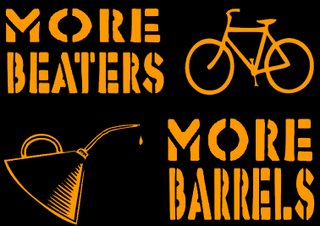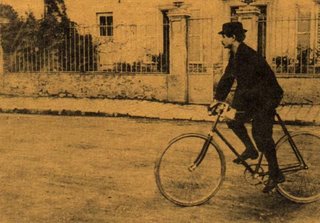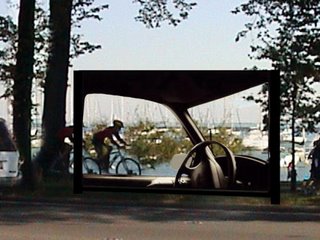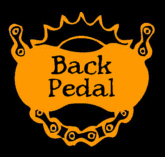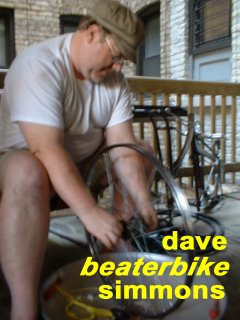 ApproachingLifeonBeaterBikes
ApproachingLifeonBeaterBikesWhen my $300 hybrid bike was
stolen two years ago, I changed the way I value things. I realized that I was wasting money to avoid knowledge by paying a mechanic to keep up my main source of transportation. In the first year alone, I had it in the shop twice, once to replace a crank and once to repair a skipping derailleur. The
manuals that came with my expensive bike counseled having a trained mechanic work on it... a fat lot of good for a DIY-type guy like me.
What may appear to be a massive rationalization, I decided to embrace
voluntary simplicity, be my own mechanic, and reacquaint myself with all things bicycle. First, I decided what I wanted in a bike; something simple, reliable, and easily-repaired. I wanted the replacement parts to be cheap and easy to repair them myself with a minimum of tools. In other words, I wanted a
beaterbike.
A
beaterbike is a reliable set of wheels that you use as a way to get from A to B. This is an inexpensive bike that is comfortable to you. It is no fashion statement to ride, though perhaps the lack of a fashion statement is a statement in itself! It doesn't have to be shiny or have 150 speeds. I aim for homely-but-reliable, because:
1. It's less likely to be stolen.
2. Since it cost less than $100, I won't be crushed if it is stolen
3. As I modify it to my own size and tastes, I learn more about it.
4. The more simple the bike, the less that can go wrong.
5. If I can trust it, I can focus my energy on deeper thoughts and preoccupations, like biking rather than bike repairing.

I hear a lot of people say they want a
beaterbike just to ride around. Often they have one, but it doesn’t work right or it has a flat tire. What I hear is that they don’t want to spend more than $50 for a bike….the equivalent of a couple of meals or a tank of gas. I also hear that they want low maintenance bikes (like today’s cars), where they can just hop on and ride.

Chicago being the former home of Schwinn Bicycle, I latched onto the idea of buying Schwinns. I bought a 1974 Suburban touring bike for $10 at a garage sale (and a $38 lock). Between that and my 1962 Traveler, I've managed to begin my beater biker lifestyle.
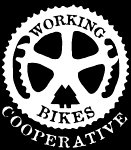
I visited a
local bike cooperative and found replacement parts for my old Schwinns and began to adapt the bikes to my body. Specifically, I bought more comfortable seats, replaced the touring handlebars with more mountain bike straight bars (I have stiff wrists with a touch of carpal tunnel from 20+ years on a computer), racks and panniers for carrying stuff, and thicker tires with denser rubber to prevent punctures. I raised the handlebars for a more upright posture (easier on the back) and bought lights, bells, and reflectors for higher visibility.
Being a knowledge manager, having access to information is important to me, so I began collecting a series of links on bike repair. Sometimes, I was impressed with online exploded drawings and technical schematics (such as the set I found for the
Sturmey-Archer hub), and in other cases, the net went little further than basic bike maintenance.

In the early 70s, I bought a book on repair and taught myself how to tear down my 1973 skyblue Schwinn Continental and rebuild it. Tim Cuthbertson's
Anybody's Bike Book was perfect for a 13-year old looking to do-it-himself. The book is out of print, but you can still get it used online. This book is the unofficial bible of bike repair; especially for older bikes.
Bike repair doesn't take electricity (other than for good lighting). Overall, hand tools, lubricant, a good air pump, and rags are all you need to keep a bike in running order. Everything on your bike is replaceable or serviceable. Grinding, squeaking, stiffness, looseness, wobblies, and screeching can all be lubricated, calibrated, cleaned, tightened or, generally, fixed by you.
 Why make it a mystery other than to perpetuate a profession?
Why make it a mystery other than to perpetuate a profession?Labels: Chicago, that which rolls, velopunk
 I got my first positive review at The Cycling Dude by Kiril, The Mad Macedonian. His site is [d]edicated to the proposition that bike riding is good for you and fun. An ordinary road cyclist spreads the word and the word is BICYCLE! It's been ranked America's #1 BikeBlog Since January 2003. It's no big surprise since it's packed with tons of links and other pertinent information on pretty much everything that has to do with bikes.
I got my first positive review at The Cycling Dude by Kiril, The Mad Macedonian. His site is [d]edicated to the proposition that bike riding is good for you and fun. An ordinary road cyclist spreads the word and the word is BICYCLE! It's been ranked America's #1 BikeBlog Since January 2003. It's no big surprise since it's packed with tons of links and other pertinent information on pretty much everything that has to do with bikes.





